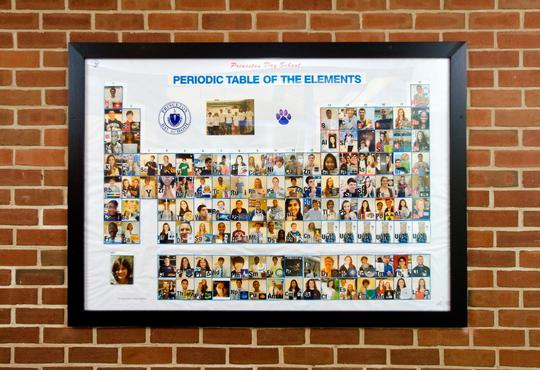Imagine some students walking into a university auditorium with 500 others. In their backpacks, the students have binders with loose-leaf paper to take notes and a couple of pens. They are not carrying cellphones, laptops or iPads. A chemistry professor walks into the room, places notes for the lecture on the podium and begins teaching. During the class, the professor writes key points on the chalk board or overhead projector, but spends a good deal of the time just speaking while the students listen carefully and take notes. Several content questions are taken up, and the steps involved in solving particular problems are shown on the board or overhead projector. After the lecture, a student goes back to his room in residence, looks over the notes he made and reads the relevant sections in the textbook. He realizes that even after studying he is confused about some of the key concepts for that unit. The student then calls his professor’s office to set up an appointment to meet later that week.
The above scenario probably seems very outdated. We have become dependent on various technologies in our everyday lives, including cellphones, email and laptop computers. Indeed, they shape the way we interact with others in many areas, including in first-year chemistry courses. The scenario described above would have been normal in a first-year undergraduate lecture twenty years ago — perhaps in the classes that you attended. If you enter our first-year introductory physical and organic chemistry lectures at the University of Toronto, the scene is very different. You will see a room full of undergraduates who are texting on their phones and using laptops and tablets while the instructor gets ready for class by connecting a laptop to the projector to show a PowerPoint presentation. A typical first-year chemistry lecture today is a combination of PowerPoint slides with worked examples solved on a tablet or overhead projector. PowerPoint facilitates use of YouTube videos and animations to clarify complex and abstract concepts, and to make the lecture more visually appealing with easy incorporation of pictures and colour. Students follow along with incomplete notes posted ahead of time on the course website and generally write down additional points of interest or examples. In addition, some classrooms use clickers which allow the lecturer to poll the audience for answers during class in order to give students a chance to engage more fully and check their understanding. Clearly, there are profound differences in content delivery in classrooms today. A stimulating university lecture will provide material and expose students to problems that cannot be accessed by other means.
Another significant difference is the method of communication between the instructor and the students. Almost all courses have websites that contain valuable information for the course, such as lecture notes, assigned problems, test announcements and laboratory information. Some websites also have a discussion board that allows students to share course information and gives the lecturer the opportunity to answer general questions. Detailed questions about chemistry still involve meeting personally with the lecturer, but the appointments are generally scheduled by email. Electronic communication encourages more students to contact instructional and administrative staff, particularly if they feel shy or intimidated about face-to-face interaction. Some faculty hold “virtual office hours” where they are available during evenings and weekends to electronically respond to undergraduate concerns. Lecturers closely monitor the effectiveness of new instructional strategies that they employ, and regularly consult the chemistry education research surrounding pedagogical enhancements related to technological changes.
Technology in the hands of students
There are several recent reports of undergraduates successfully working with technology within the classroom, for example by using smartphones as personal response systems.1-3 However, from our perspective it is clear that certain technologies are misused by students during lectures. An obvious and simple example is the regular checking of email, Facebook or Twitter, perhaps by using an iPhone or laptop. Notably, a history professor at Yale University faced student discontent when he moved his class to a room that did not have wireless capability.4 The Educational Development Centre at Carleton University in Ottawa has published an instructional guide entitled “Wireless Internet Access in the Classroom”.5 Here it is stated that students are no longer a captive audience in lecture, with many forces competing for their attention. Lecture room management techniques are discussed, including a ban of laptops in class, as completely disabling wireless access is a “technical impossibility”. The guide goes further to say “(it is) culturally and socially difficult for undergraduates to avoid the immediacy of online communication. ”
A problem also exists in situations where students believe they are using technology to study in a smart and time-efficient manner when in fact they are not. One example of this is taking digital photographs of class slides. Many instructors post “skeletal” web notes to encourage engagement and active note-taking during lectures, or work through problems that are presented in class for the first time. Waiting until a problem is completely solved or all the information on a slide is visible and then taking a picture of it is a passive and lazy form of learning. Reviewing these “snapshots” after class is taking a surface-learning approach to the material. Secondly, recording lectures (now often done secretively with any number of electronic devices) is a popular strategy. This sounds like a great idea, as a student can theoretically go back after class and review every single word of what was said by the instructor. However, two issues arise here. If the “review” is done on a subway ride home, or whilst a student is working out at the gym, it is just another type of passive study. In addition, it is extremely time-consuming to go home and listen to recordings to make extra notes, considering that students have to consult textbooks and spend time solving problems. It is usually much better to become a good note taker in class!6 In fact, although content delivery by instructors using laptops appeals to a wider variety of learning styles, it could be the case that students are losing the ability to take detailed lecture notes on their own. A related point is that of copyright violation — at our institution and others, the following policy is in effect: “the unauthorized use of any form of device to audiotape, photograph, video-record or otherwise reproduce lectures, course notes or teaching materials provided by instructors is covered by the Canadian Copyright Act and is prohibited.”7
Some final thoughts
Understanding chemistry and the principles of other physical sciences has always been a challenging pursuit. A popular perception is that learning is made easier today by the rapid advances made in teaching with technology. Molecular visualization methods have undoubtedly improved with the advent of new computational techniques. Reaction mechanisms can be simulated and represented in a manner that was unimaginable even a decade ago. However, the vast majority of students will ultimately still answer term test and final examination questions using pen and paper. They will be required to draw molecules that exist in three dimensions on a two-dimensional surface. The perceived short cuts that technology facilitates (downloading lecture notes as a substitute for coming to class, taking pictures, making recordings, emailing content questions to instructors instead of attending office hours or participating in study groups) are liable to lead to compromised learning and superficial understanding of core concepts. The importance of being an active, focused learner who uses technology appropriately cannot be overstated, and requires that students are honest with themselves about effective engagement in lectures and use of time when studying outside of class.
Literature cited (accessed November 2013)
- M.L. Cole, D.B. Hibbert, E.J. Kehoe, Journal of Chemical Education, 2013, 90, pages 671-672.
- A.W.M. Lee, J.K.Y. Ng, E.Y.W. Wong, A. Tan, A.K.Y. Lau, S.F.Y. Lai, Journal of Chemical Education, 2013, 90, pages 388-389.
- A.J. Williams, H.E. Pence, Journal of Chemical Education, 2011, 88, pages 683-686.
- Yale Professor Moves Class to Room Without Wi-Fi. Cue Outrage. http://newsfeed.time.com/2012/02/01/yale-professor-moves-class-to-room-without-wi-fi-cue-outrage
- Wireless Internet Access in the Classroom Technology Guide, Carleton University. http://edc.carleton.ca/docwall/Wireless%20in%20the%20classrom/Wireless%20in%20the%20classrom.pdf
- K.B. Quinlan, A.P. Dicks, Chem 13 News, 2013, 398, pages 6-7.
- University of Toronto Copyright Considerations. www.teaching.utoronto.ca/topics/strategies/classroom-management/recording-lectures/copyright.htm.







